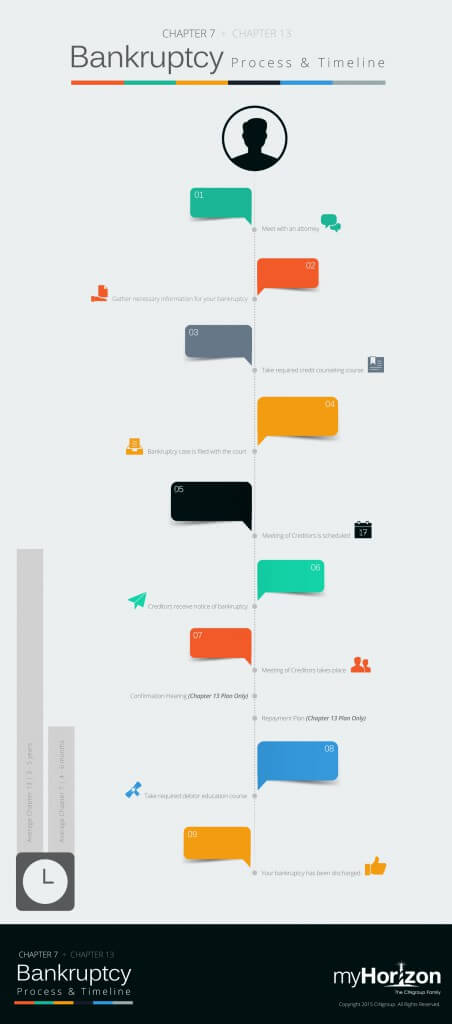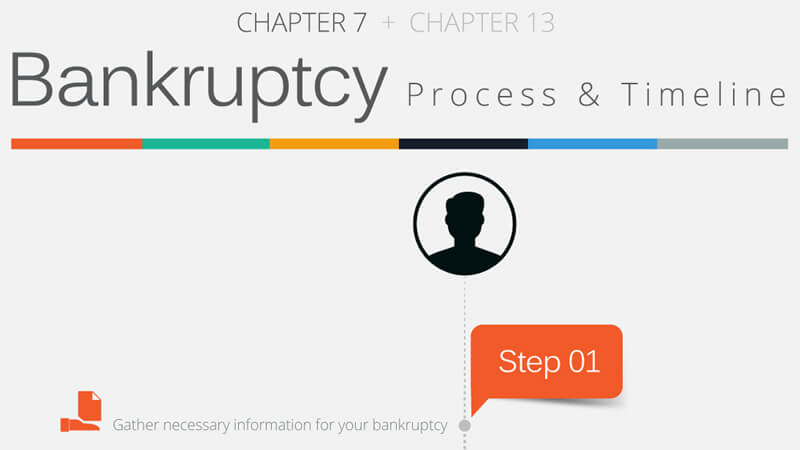As you begin your bankruptcy journey, it’s good to know the route and how long it will take to get to your final destination of financial freedom. If you are filing under chapter 7, then you can expect it to take four to six months to discharge your debts. If you are filing under chapter 13, then you can expect it to take three to five years to repay your debts according to the terms of your court-approved repayment plan. This is a general timeline and may vary depending on where your bankruptcy case is filed.

You will want to start by seeking out professional advice and contacting an attorney. Most attorneys provide a free consultation to look at your finances. Be sure to bring all your financial information as it will inform the attorney on what legal options are available to you. Feel free to talk with as many attorneys as you need until you find one with whom you are comfortable. Read an interview with a bankruptcy attorney on what to expect in your initial consultation.
Step 2: Gather necessary information for your bankruptcy
This may be the most challenging and tedious part of the bankruptcy process. To help get you started, here is a list of information and documents you will need to provide to your attorney.
Step 3: Take required credit counseling course
Before you file for bankruptcy, you are required by law to take a credit counseling course. The course will provide you with information on alternative solutions to bankruptcy. It focuses on income, expenses, and debts to assess if you are able to pay off your debt by way of a repayment plan, thus avoiding bankruptcy. You will want to have your financial information gathered as the credit counseling provider will require it to determine whether a repayment plan is feasible for you. Although you are required to attend and complete the course, you do not have to follow the credit counseling provider’s recommendations and repayment plan. Most often the course determines that you have no other option than bankruptcy.
The course is usually available online, by phone, or in-person and must be completed within 180 days prior to filing. If you take the course online or through an automated phone system, you will be required to talk to a counselor over the phone, by live chat, or email after the course. The counselor will provide you with a written budget analysis and recommendations based on your specific financial situation. Your course will not be complete until you talk to the counselor.
You will need to get your certificate of completion from the provider in order to prove that you have taken the course. You need to make sure that your attorney has the credit counseling certificate of completion before you file for bankruptcy.
Step 4: Bankruptcy case is filed with the court
The good news is now that you have filed bankruptcy creditors must stop their calls, pending lawsuits, and or wage garnishments.
Step 5: Meeting of Creditors is scheduled
The primary purpose of the meeting of creditors, or Sec. 341 meeting, is to confirm that your bankruptcy petition is accurate, to determine if you have any non-exempt property, to review your repayment plan, if you’re filing a chapter 13 bankruptcy, and to give the trustee and interested creditors the opportunity to question you.
Step 6: Creditors receive notice of bankruptcy
Legally, your creditors must be notified you are filing bankruptcy. They are sent a notice after you file and have the right to appear at the meeting of creditors.
Step 7: Meeting of Creditors takes place
This meeting of creditors typically takes place at a federal building in a meeting room with other debtors, the trustee (who looks over the case), and, in some cases, creditors. This meeting typically will take place within 40 days after you file bankruptcy.
Before attending the meeting, the bankruptcy trustee will examine your bankruptcy petition. He or she may have some questions about it and will present those questions to you at the meeting.
In the typical bankruptcy case, creditors do not attend. However, if they do attend, it may be because they are a secured creditor such as a car lender. In that case, they are likely attending to determine if you want to give up, also known as surrendering, the property.
Please note that you must arrive at the meeting with proof of your identity such as a government- issued photo ID and proof of your social security number.
Step 8: Confirmation Hearing (CHAPTER 13 ONLY)
A chapter 13 plan must be confirmed before it is finalized. Creditors, trustees, and other interested parties will have an opportunity to review the plan and object to its terms. The timing of this hearing depends on where your case is filed but it usually takes place within 45 days after the meeting of creditors. If there are objections to your plan, then the objecting creditor will present the motion in court and the judge will make a decision on the matter.
Step 9: Repayment Plan (CHAPTER 13 ONLY)
In a chapter 13 repayment plan you agree to make payments to pay off the full or partial amount of your debts to your creditors. The length of the plan will depend on your monthly income and the amount of time you need to pay off the debts. You can ask to modify your chapter 13 plan if there is a change in your income or financial circumstances.
Step 10: Take required debtor education course
The debtor education course gives you the tools and knowledge to help you to avoid bankruptcy in the future. The course focuses on your financial life after bankruptcy. You will want to have your financial information gathered as you will learn how to create a budget, best practices on using credit, creating a savings account for emergencies, and other money management tips.
The debtor education course is usually available online, by phone, or in-person. If you file a chapter 7, you will need to take the course within 60 days after your 341 meeting, and, if you file a chapter 13, you will need to take the course before you make your last plan payment. If you take the debtor education course online or through an automated phone system, you will be required to take and pass a test after the course. If you take the course over the phone, the test will be given in person or over the phone. If you took the course online, then the test will be given by phone, email, or live chat. Please note that you must take and pass the course before you receive the certificate of completion necessary to have your case discharged.
Step 11: Bankruptcy is discharged
You now have gained financial freedom and debt relief.
Once you have successfully navigated the bankruptcy process it’s important to start taking the steps to ensure your fresh start. Begin by making sure your bankruptcy is accurately reflected on your credit report and setting up credit monitoring to make certain those debts don’t return.



